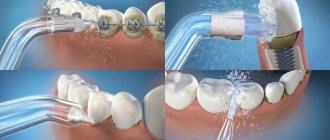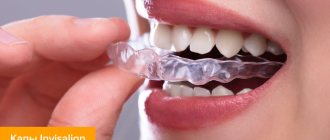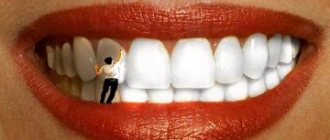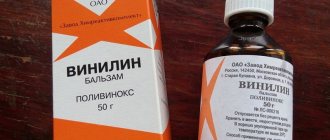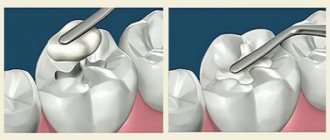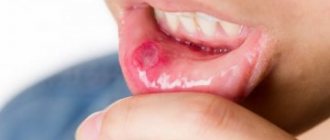Dental intervention aimed at eliminating pathological and abnormal conditions does not always require effort from the patient. A night dental guard for teeth is used as part of the treatment of bruxism, to correct the anatomical structure of the bite, in the treatment of TMJ dysfunction - and does not cause any inconvenience, since the positive effect on problem areas is created during sleep. The configuration of the elastic pads eliminates the danger of operation and guarantees the achievement of the desired result.
Why is bruxism dangerous?
Bruxism is uncontrollable grinding or clenching of teeth due to spasms in the chewing muscles. This is a fairly common phenomenon, but not all patients realize that the disease poses serious problems:
- pathological abrasion of tooth enamel;
- loss of fillings, crowns;
- dysfunction of the temporomandibular joint (clicking, pain when opening/closing the mouth);
- chronic insomnia and fatigue;
- headaches, dizziness.
Teeth grinding is mainly characteristic of the night, when a person is sleeping and does not control the movements of the jaw. However, in many patients the problem also manifests itself during the day - they involuntarily clench their teeth under stress or when concentrating.
Indications and contraindications
The main indication for use is the presence of symptoms of bruxism in a person. It does not matter how often and intensely they manifest themselves. The use of such structures is absolutely safe, so it cannot bring any negative consequences.
The age of the patient also does not matter. Mouthguards are very actively used in pediatric dentistry. This is due to their great efficiency and ease of use. However, in this case it is important to remember that children, due to their nature, may deliberately remove the plate. Therefore, to ensure quality treatment, it is necessary to conduct explanatory conversations with them and monitor the implementation of recommendations.
Other indications for use include:
- deformations of the dentition of various types;
- presence of malocclusion;
- the gaps between the teeth are too large or, conversely, too small.
All these problems can occur against the background of bruxism symptoms. In this case, the mouthguard will have a complex purpose.
As for contraindications, they practically do not exist. The structures are made from safe materials; they are securely attached to the teeth and do not cause discomfort. However, if the patient has certain mental disorders, he may be denied a mouth guard. Epilepsy is especially dangerous in this case. During an attack, the patient may accidentally swallow the plate, after which it will block his airway, thereby causing suffocation.
How is bruxism treated?
If a problem occurs, you should contact an orthodontist. He will select a special mouth guard to wear while you sleep. It is an elastic dental splint made of biocompatible plastic. This orthodontic design responds to the load when the patient compresses the dentition, preventing the chewing muscles from overexerting. As a result, the lower jaw relaxes and muscle hypertonicity goes away. Treatment will be effective if you wear the mouth guard for at least 10 hours a day.
Features and Benefits
The price of a dental night guard for teeth consists of several factors, which primarily include the selected material and manufacturing technology. Onlays used in orthodontics are designed to be worn while sleeping, which allows them to solve a wide range of problems. Modern models, created taking into account the development of the dentition and bite, are recommended in the following situations:
- Retention. Treatment with braces is a long and complex process, which, unfortunately, does not end when the metal structure is removed. Retainers secure the correct position of the elements of the dentition and prevent their reverse displacement.
- Bruxism. Among the pathologies of the jaw region that have a negative impact on the structure of the dentition, one of the most complex phenomena is considered to be bruxism - uncontrolled grinding, attacks of which most often occur during sleep. Excessive pressure on the enamel leads to its damage and destruction, so the best solution would be to buy a night guard for your teeth. Elastic products not only prevent intense occlusal closure, but also relieve stress on muscles and ligaments, helping to correct the bite.
- Snore. The cause of night snoring is often pathologies of the nasopharynx, as well as insufficient muscle tone. Using a mouthguard during sleep helps restore smooth breathing, prevents sound terror, and over time completely eliminates the pathology.
- Whitening and remineralization of enamel. Common difficulties that arise in patients who abuse bad habits include pigmentation and thinning of the enamel coating of the teeth. An increase in sensitivity and a deterioration in the aesthetics of a smile require medical intervention. Thanks to night guards, the use of special fluoridating compounds that strengthen the structure of dental tissue, as well as restoring its natural whiteness, does not create problems for your usual lifestyle.
The choice of a specific orthodontic corrector is determined by clinical indications obtained during diagnosis.
Purposes of using a night guard
- Prevent abrasion of tooth enamel.
- Relieve tension in the chewing muscles of the jaw.
- Normalize the functioning of the temporomandibular joint.
Often, wearing a sleep guard is the first step in correcting your bite and precedes the installation of braces. And in some cases, mouthguards are worn when braces are already installed to protect them from accidental breakage due to involuntary clenching of the jaws. They can also serve as protection for crowns and fixed dentures.
How are mouth guards made for teeth grinding?
The manufacture of these structures is carried out in special laboratories. For this purpose, modern high-quality polymers are used. They are resistant to mechanical and chemical influences and also have a long service life. Such materials can have different colors - from transparent to any bright shades.
To custom make a structure for bruxism, a specialist must first make an impression of the patient’s jaw. This is necessary in order to see the exact location of the jaw, as well as to note all the irregularities of the dentition. Thanks to this, you can make a model that exactly matches the surface of the teeth and will not cause discomfort while wearing.
Production time
The time required to manufacture the structure depends on the material used, as well as on the structural features of the patient’s dentition. There are cases when, after fitting, the doctor identifies certain inconsistencies that also need to be eliminated.
Usually it is possible to make a high-quality structure for the treatment of bruxism in 1-1.5 weeks. If there are serious violations, the dentist may recommend urgent production.
Important! The period required to manufacture the structure should be taken into account when ordering a second copy. Since there can be no pauses in therapy, it is better to order it even before the first one becomes unusable.
Custom mouthguards for bruxism
These are orthodontic structures that are made in a dental laboratory based on impressions of the jaw of a particular patient. They are used in severe cases of the disease, when the symptoms of bruxism are significantly pronounced and serious correction of the dentition is required. The more accurately the design is selected, the more effectively it affects the jaw muscles. Usually, after the patient puts on a dental guard, 10-15 minutes are enough for the muscle spasm to go away and the headache or neck pain to subside. The downside of these structures is that they take quite a long time to produce - up to several weeks, and the patient often needs to start treatment as soon as possible.
What tasks does the mouthguard cope with?
A dental mouthguard also performs the following tasks:
- an individual mouthguard provides prevention of dental misalignment;
- helps maintain the integrity of the enamel, and, therefore, reduce the likelihood of developing caries;
- reduces the risk of developing the consequences of bruxism, namely, headaches, pain in the projection of the jaw, which can radiate to the back and neck.
Dentistry for those who love to smile
+7
Make an appointment
Mouth guards made using neuromuscular technology
The neuromuscular mouthguard is a unique development of sports dentists; the device not only protects the athlete from injury, but also increases the strength of the shoulder girdle muscles by 30%. For the average person, this result seems implausible, but the effectiveness of neuromuscular mouth guards has been proven.
Scientific studies have found that athletes constantly clench their teeth during training and competition, which leads to tension in the muscles of the neck, shoulders and back. Unnecessary muscle tone leads to loss of energy, and this affects the athlete’s strength performance and reduces athletic performance. Neuromuscular mouthguards solve the problem - they allow you to fix the position of the lower jaw in such a way that the muscles are in a state of minimal tension at the moment of clenching the teeth. Thanks to this, the athlete’s muscular frame is stabilized, and the amount of energy required for victory increases.
These mouthguards are the most customized and expensive.
Our clinic’s specialists manufacture individual Dental Guard sports mouthguards (Agility Guard company) using neuromuscular technology in this way: electrodes are fixed on the client’s face and neck, which transmit a signal about the strength of muscle contraction to the computer screen. The athlete opens and closes his mouth, while the dentist, based on sensor readings, looks for a position in which muscle tension reaches a minimum value. When such a position is found, a mouth guard is made in the laboratory based on the impression and computer data.
What does a neuromuscular mouth guard provide to an athlete:
- Increases strength and endurance;
- Reduces sensitivity to pain;
- Improves accuracy and speed of movements;
- Prevents the impact force from being reduced when re-stressing.
Due to the fact that the mouth guard improves strength and speed performance, it is used by athletes in those sports where dental protection is not traditionally used. In this case, a mouth guard is made without a protective function; its purpose is to eliminate reflex overstrain of the muscles of the shoulders, back and arms.
Night guards for straightening teeth
Being elastic, the product does not injure the gums. The trays are completely colorless and cannot be seen in the mouth. There are models that need to be worn not only at night, but also during the day. Such structures need to be removed only for eating and during hygiene procedures. Unlike braces, they are easy and quick to take off and put on. Aligners are made individually for each patient and are usually supplied in a set, which can contain from two to thirty pieces, depending on the course of treatment. The aligners need to be changed once every 1.5-3 months.
Kinds
Alignment aligners are very diverse. Depending on the manufacturing method, the product may be:
- Individual - they are made for a specific patient. A 3D model of the jaw is first made. Such products are effective and convenient.
- Thermoplastic - made from a special material that can soften in warm water. Heated products are placed on the dentition. The cooled mouthguard will take the required shape.
Depending on what material the product is made of, aligners can be silicone or plastic. Both options are very similar.
By wearing time:
- Those that need to be worn 24 hours a day. Dentists recommend wearing these aligners 22 hours a day and removing them only before brushing your teeth and eating.
- Sleep guards. Used to eliminate minor anomalies. They are also used when there is a need to consolidate the result after a course of wearing braces. Night guards are worn only at night. Silicone mouth guards for teeth at night are especially popular.
According to age category, there are:
- For adults. According to statistics, mouth guards are more often used for adult patients.
- Children's night guards for teeth. Children are reluctant to wear orthodontic appliances, so treatment can take quite a long time. Due to their specific characteristics, children's teeth can be straightened quite quickly if you follow the dentist's recommendations. Children's mouthguards are very comfortable and do not differ from models for adults. In terms of function, these are absolutely identical products.
Types, requirements and functions
The functional requirements for silicone mouthguards used as part of general therapy for bruxism include:
- Preservation of the structure of the enamel surface;
- Preventing the formation of defects;
- Prevention of mechanical damage;
- Relieving stress on the TMJ;
- Normalization of sleep, restoration of free breathing;
- Protection of fixed orthodontic correctors.
The variety of technologies and protocols on which the products are manufactured allows you to choose a mouth guard taking into account medical recommendations, as well as taking into account the wishes of the patient. The traditional classification used in dentistry involves the use of various differentiating criteria, such as:
- Wearing time. There are night and day guards. In the first case, the pad is used only during sleep, while models of the second type are used almost around the clock - with the exception of meal breaks.
- Product size and configuration. There are one- and two-jaw models. In this case, the choice of design is determined by medical indications that characterize the degree of intensity of abrasion of the enamel coating in the occlusal area (points of contact when teeth are closed).
- Manufacturing technology. There are universal, individual and thermoplastic mouthguards. The first category consists of products formed on the basis of a standard template - the line provides several types of sizes, and does not take into account the peculiarities of the anatomical structure in each specific case. Such mouth guards can serve as temporary protection, but they are not effective in correcting and treating the pathology. Individual models are created based on the results of a clinical examination - thanks to the development of technology, you can order the production and buy a mouthguard for teeth for bruxism in many dental clinics. Thermoplastic models are blanks made of a special polymer material that changes shape when heated - the devices are distinguished by the accuracy of repeating the topography of the row, but have a short service life.
Another aspect is functional purpose. From this point of view, there are mouthguards for complex therapy, as well as repositioning products. In the first case, the task of the corrector is to protect the tooth enamel from trauma, damage and the formation of defects, in the second - to restore the natural position of the TMJ.
The use of biologically compatible materials eliminates the occurrence of an allergic reaction, which makes it safe to install mouthguards in the treatment of bruxism. Compliance with medical recommendations related to oral hygiene care, as well as the duration of wearing, guarantees the achievement of the desired result.
General overview
An unloading tray is an overlay made of elastic material that follows the shape and fits tightly along the entire length of the dentition, the task of which is to redistribute the load on the jaw region. The installed orthodontic apparatus helps relieve pain, eliminate muscle hypertonicity, as well as normalize the occlusal relationship and jaw balance.
The use of biocompatible materials eliminates the development of an allergic reaction and a health hazard when wearing the corrector for a long time. The ease of removal and installation makes the use of the mouthguard comfortable even for patients of a younger age group, and the aesthetic appearance eliminates the psychological problems inherent in wearing permanent corrective structures.
Universal
They are characterized by a less pronounced effect on the correction of teeth, and, therefore, do not give such a high result in the treatment process than the product described above. Its undeniable advantage is the low price.
Flaws:
- The model has a standard shape and is not able to take into account the anatomical features of the structure of the jaw apparatus;
- In the production process of mouth guards, mainly low-grade materials are used, which often provoke allergies. They can cause discomfort during use, and in some cases can provoke the development of malocclusions, which will subsequently have to be further treated.
The use of universal mouthguards is necessarily accompanied by complex therapy, taking medications containing large quantities of calcium, which strengthens bone tissue, magnesium and vitamin B complex.
It is important to understand that if this disease is the result of bite deviations, in parallel you should be observed by an orthodontist and, if necessary, receive appropriate treatment.
Another significant drawback of universal models is the appearance of bad breath. This arises from the fact that the material, which is of low quality, absorbs foreign odors, which are then almost impossible to eliminate.
Reasons for the development of pathology
The appearance of snoring is explained by a narrowing of the lumen of the upper respiratory tract, which during wakefulness is in good shape and retains the elasticity of the walls. At night, the muscles relax a little, the walls of the airways move and begin to vibrate when breathing. We hear this vibration as snoring.
There are quite a few reasons why snoring occurs. The most common are:
- anatomical disorders leading to narrowing of the airways, including a deviated nasal septum;
- congenital narrowness of the airways;
- nasal polyps;
- malocclusion, small jaw, displaced back;
- enlarged tonsils;
- fat deposits in the throat area due to excess weight;
- elongated uvula.
There are also factors that contribute to the reduction of nasopharyngeal muscles, regardless of the presence of diseases. These are alcohol intake, lack of sleep, use of sleeping pills, menopause or thyroid dysfunction.
Snoring is a symptom of one of the most unpleasant diseases - obstructive sleep apnea syndrome. Because of it, a person periodically stops breathing altogether during sleep. This leads to decreased oxygen levels in the blood, frequent awakenings, drowsiness, and other problems.
Efficiency
The first thing to clarify is that a mouthguard for bruxism is not a treatment. It only eliminates symptoms and protects teeth from destruction or loosening. Essentially, she takes the hit herself. Instead of wearing away enamel and dentin, you destroy plastic, which can then be replaced with a new one, created from a ready-made exact cast of your jaw.
Considering that among the main causes of teeth grinding are psychological issues related to stress and other problems, you need to combine the use of mouthguards with the help of a psychologist, the use of massages and other methods of relaxation. If necessary, medications may be prescribed. You may need to consult a neurologist.
What is a night guard for straightening teeth?
Aligners or aligners are popular and in-demand designs. They were first used about fifteen years ago. A mouthguard is a special silicone pad that is placed on the surface of the teeth. In addition to silicone, mouth guards can also be made from other materials that have sufficient elasticity. These products are placed directly on the teeth. They have the most soft and gentle effect. It should be said right away that mouth guards are only necessary for minor bite pathologies. Only braces can cope with serious anomalies. Quite often, dentists prescribe patients to wear mouth guards after removing braces in order to consolidate the result. You can find out how much it costs to make a structure from your doctor.
Advantages and disadvantages
The main advantage is the ease of use of the record. At the right time, the patient simply puts on the mouthguard and can also easily remove it. It is very easy to care for the device. To arouse interest among very young patients, the design can be decorated with drawings.
The main disadvantage is the adaptation period. It takes about a week to get used to the design. But, taking into account the nuance that with bruxism, as a rule, mouthguards are worn only during sleep, this disadvantage disappears.
Care of mouth guards
- After wearing the protective mouthguard, it is enough to rinse it with running water at room temperature and dry it; periodically, you can use a toothbrush and toothpaste for cleaning;
- Do not dry the mouthguard with a hairdryer;
- Before putting on the mouth guard, wash it with a solution of chlorhexidine (sold ready-made at the pharmacy) or mouth rinse;
- It is best to store the product in a special container with holes for ventilation to prevent an unpleasant odor;
- During storage, the product should not be exposed to direct sunlight;
- Mouth guards need to be changed periodically, as constant use causes them to deform and become thinner in the area of the cutting edges. In addition, long-term use of the same mouthguard is unhygienic; ideally, replacement should be done every six months;
- Children's protective mouthguards are replaced as the jaw grows, bitten sports mouthguards are replaced with new ones immediately.
What does the effect depend on?
The effectiveness of anti-snoring devices largely depends on the characteristics of the human body. If the problem is caused by several respiratory diseases at once, the result of wearing it will not be very pleasing. Still, the mouth guard mainly helps with malocclusion and jaw shifting back. If a patient has polyps, they should be treated first.
It is also worth keeping in mind that the type of mouthguard may affect the effectiveness of wearing it. Typically, individual models give the best effect, but their cost is very high, so the doctor often prescribes a test product first. This mouth guard is the simplest monoblock made from the cheapest materials. If improvements appear within a week of wearing, the specialist recommends purchasing an individual mouthguard.
Recommendations for care and storage
It is very easy to maintain the structure. To do this, you should adhere to the following recommendations:
- After use, it must be rinsed with running water to remove bacteria, food debris, etc. If it becomes very dirty, you can use your usual toothpaste and brush.
- After washing, the structure should be carefully wiped.
- Do not expose the plate to high temperatures. It should not be boiled or dried with a hairdryer. Also, do not leave the plate in the open sun.
Throughout the entire period of using the bruxism mouth guard, the patient should carefully monitor its condition. If any deformations occur in the design, this may indicate that it is not suitable, or that the person has begun to experience complications. In each of these cases, you must immediately consult your doctor.
It is better to use special containers for storage. They can be ordered during the purchase of the structure itself. They will keep the plate clean and prevent any damage.
